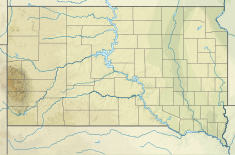| Big Bend Dam | |
|---|---|
 Big Bend Dam on the Missouri River, with Lake Sharpe in the background. | |
| Official name | Big Dam |
| Country | United States |
| Location | Buffalo/Lyman Counties, South Dakota. |
| Coordinates | 44°02′58″N 99°26′55″W / 44.049473°N 99.448586°W |
| Status | Operational |
| Construction began | 1959 |
| Opening date | 1963 |
| Construction cost | $107 million |
| Owner(s) | |
| Dam and spillways | |
| Type of dam | Embankment, Rolled-earth shale fill & chalk fill |
| Impounds | Missouri River |
| Height | 95 ft (29 m) |
| Length | 10,570 ft (3,222 m) (including spillway) |
| Elevation at crest | 1,423 feet msl |
| Width (base) | 1,200 ft (366 m) |
| Dam volume | 17,000,000 cu yd (12,997,433 m3) |
| Spillways | 8 - 40-foot x 38-foot tainter gates |
| Spillway type | controlled (gated) |
| Spillway capacity | 270,000 cfs at 1,423 feet msl |
| Reservoir | |
| Creates | Lake Sharpe |
| Total capacity | 1,798,000 acre⋅ft (2.217800344×109 m3) |
| Catchment area | 5,840 sq mi (15,126 km2) |
| Surface area | 56,884 acres (23,020 ha) |
| Maximum length | 80 mi (129 km) |
| Maximum water depth | 78 ft (24 m) |
| Normal elevation | 1,420-1,423 feet msl |
| Power Station | |
| Operator(s) | U.S. Army Corps of Engineers |
| Commission date | October 1964 |
| Turbines | 8 Fixed blade, 81.8 rpm |
| Installed capacity | 494,320 kW |
| Annual generation | 969 million kilowatt hours |
| Website U.S. Army Corps of Engineers - Big Bend Dam / Lake Sharpe | |

Big Bend Dam is a major embankment rolled-earth dam on the Missouri River in Central South Dakota, United States, creating Lake Sharpe. The dam was constructed by the U.S. Army Corps of Engineers as part of the Pick-Sloan Plan for Missouri watershed development authorized by the Flood Control Act of 1944. Construction began in 1959 and the embankment was completed in July 1963. Power generation began at the facility in 1964 and the entire complex was completed in 1966 at a total cost of $107 million. The hydroelectric plant generates 493,300 kilowatts of electricity at maximum capacity, with an annual production of 969 million kilowatt hours,[1] and meets peak-hour demand for power within the Missouri River Basin.
Located near Fort Thompson, South Dakota, just south of the Big Bend of the Missouri River, a large meander, Big Bend Dam creates Lake Sharpe, named after South Dakota Governor Merrill Q. Sharpe. The lake extends for 80 miles (130 km) up the course of the Missouri River passing through Pierre, the State Capitol, to Oahe Dam, another major power-generating and flood control dam. Lake Sharpe covers a total of 56,884 acres (23,020 ha) and drains an area just under 250,000 square miles (650,000 km2).
South Dakota Highway 47 crosses over the dam, connecting Lyman and Buffalo Counties. Big Bend Dam is located approximately 17 miles (27 km) north of I-90, and approximately 60 miles (97 km) southeast of Pierre.
The next dam upstream is Oahe Dam, near Pierre, and the next dam downstream is Fort Randall Dam, near Pickstown.
- ^ "Summary of Engineering Data – Missouri River Main Stem System" (PDF). Missouri River Division. U.S. Army Corps of Engineers. August 2010. Archived from the original (PDF) on 2012-02-07. Retrieved 2012-08-17.
